- Find an office
-
File Your Taxes
 Find a Location
Find a Location -
Resolve Tax Issues
 Resolve Tax Issues
Resolve Tax IssuesResolve Tax Issues
-
Tax Resources
 See all Tax Help
See all Tax HelpTax Tools
Tax Tips & Resources
- Where's My Refund
- Refund Advance
- Promotions & Coupons
- Hiring Local Jobs!
- Careers
- Search
- Contact Us
- Feedback
-
 Log in | Sign up
Log in | Sign up

JH Accounts
|
|
Oh no! We may not fully support the browser or device software you are using ! To experience our site in the best way possible, please update your browser or device software, or move over to another browser. |

We can help resolve your tax issues. Call (855) 357-8933 today.

BACK TAXES AND TAX DEBT
What is the IRS Fresh Start Initiative?
Many people who owe back taxes to the IRS still hear about the IRS Fresh Start Initiative on the airwaves. Many ads tout Fresh Start as an opportunity to settle back taxes with the IRS.
The Fresh Start Initiative began as a series of major IRS collection policy changes in 2011 and 2012, to help taxpayers who were struggling to pay their back taxes. The IRS announced two major changes to its collection policy, which are still in effect today.
2011: Relaxed lien-filing criteria and installment agreement terms.
In 2011, the IRS made several changes that provided relief from federal tax liens and allowed more taxpayers to obtain favorable payment terms with the IRS.
- Relaxed lien-filing criteria: Before this change, the IRS filed a tax lien on tax balances above $5,000, when taxpayers hadn’t set up a qualifying installment agreement. With this change, the IRS increased the tax balance limit to $10,000.
- Ability to request lien withdrawal: The IRS gave taxpayers the opportunity to have their tax lien withdrawn if they meet certain criteria. Lien withdrawal basically says to creditors that the lien never existed. This helps taxpayers access credit if needed.
- Expansion of streamlined installment agreement terms: Streamlined installment agreements (SLIAs)have always allowed taxpayers to get payment plans with more favorable terms and–critically–avoid federal tax liens. In 2011, the IRS expanded streamlined payment plans to allow taxpayers to set up a SLIA when they owe up to $50,000 (increased from $25,000). The IRS also increased the time to pay the balance from 60 months to 72 months. People who set up a SLIA are now able to avoid a tax lien if they paid by direct debit on balances between $25,000 and $50,000.
- In 2011, the IRS also emphasized that taxpayers who owe any amount should be able to pay over 6 years on their current budget. Before, IRS collection agents tried to maximize taxpayers’ monthly payments by disqualifying certain discretionary expenses. Fresh Start made it clear: If someone can pay their tax debt within 6 years (or by the collection statute expiration date, whichever is shorter), the IRS may allow discretionary expenses. The IRS calls these conditional expenses, meaning they’re allowed on the condition that the taxpayer can pay within 6 years. This provision became less attractive in 2020, when the IRS started to allow taxpayers who owe up to $250,000 to pay their tax bill with payment terms up to the collection statute (generally 10 years).
2012: Changes to the offer in compromise program
In 2012, the IRS made more changes. Most of these changes gave more taxpayers access to the offer in compromise (OIC) program.
The IRS made the OIC program more attractive by:
- Revising calculation of the taxpayer’s future income
- Allowing taxpayers to repay student loans
- Allowing taxpayers to pay state and local past-due taxes
- Expanding the allowable living expense category and amount
- Reducing the offer amount for people who qualify for an OIC
For example, if you qualify for an OIC, have $500 in monthly disposable income and $5,000 in net equity in assets, you would see your OIC offer amount drop to $11,000 from $29,000 (pre-Fresh Start). Fresh Start changes like these made the OIC more attractive. However, after a surge in OIC applications in 2012 and 2013, OIC applications and approvals have declined. In fact, in 2020, the IRS accepted fewer OICs (13,980 accepted) than the last pre-Fresh Start year in 2011 (20,000 accepted).
When you owe taxes, check all your options
The best thing to do when you owe taxes is to see whether you can reduce the amount you owe. Depending on your situation, you should consider solutions such as:
- Penalty abatement
- Amending your return to correct the taxes due
- Requesting audit or CP2000 reconsideration or tax return adjustments
If you still owe and can’t pay, consider several collection alternatives including:
- Extensions to pay
- Installment agreements (monthly payment plans)
- Temporary payment deferral called currently not collectible status (if you are in financial hardship)
- An OIC to settle your tax bill for less than you owe (if you are in financial hardship)
Get more help
For help creating a strategy to address your tax issue, visit Jackson Hewitt’s Tax Resolution Hub to see how we can help you.
When every dollar matters, it matters who does your taxes™
-
TRUSTED GUARANTEES.
Be 100% certain about your money & your taxes, year after year.
-
NATIONAL PRESENCE. LOCAL HEART.
We’re in your neighborhood & inside your favorite Walmart store.
-
40+ years. 60+ million returns.
The kind of trusted expertise that comes with a lifetime of experience.





